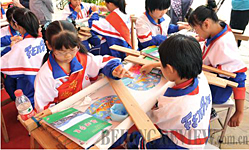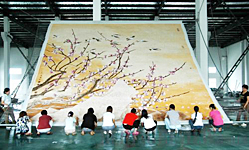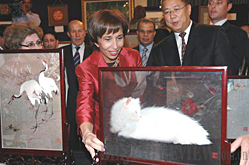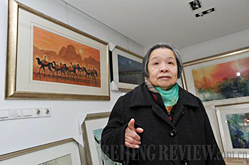|
 |
 |
|
YOUNG HEIRS: Students in Jiangsu Province practice the art of embroidery at the Third Chinese Embroidery Culture and Arts Festival on September 28, 2010 (QIAN QIANG) |
HUGE WORK: Fifty-six artisans are engaged in the creation of a work on plum blossom in Suzhou. The work, which measures 6.28 by 7.11 meters, required 90 days and nights to complete (ZHU GUIGEN) |
When late Chinese leader Deng Xiaoping visited the United States in January 1979, a double-sided embroidery Little Cat, created by Gu's apprentice Yu Fuzhen, was given to then President Jimmy Carter as a gift. In September 1981, when Carter visited China, he paid a special visit to the Suzhou Embroidery Research Center to appreciate the embroidery works of Master Gu and her colleagues and expressed his thanks to them.
At the beginning of 2005, Carter invited Gu to the United States to introduce Su Embroidery to Americans. Her apprentice Yu accepted the invitation since Gu was too old to go. Of the 31 pieces of embroidery works that were displayed, 21 were created by Master Gu. Gu, together with another Su Embroidery artisan Li Eying, was chosen as a representative heir of Su Embroidery and was listed among the first group of representative heirs of the state-level intangible cultural heritage items on June 5, 2007.
Development and protection
"In the past, embroidery artisans used to seek inspiration from calligraphic works, paintings or photos. But doing this may violate others' intellectual property rights," said Yu Meihua, President of the Zhenhu Embroidery Association. "Copyright is a problem we can't ignore."
In order to solve this problem, Zhenhu has tried to cultivate the artistic sense of embroidery artisans and has established a means for trading embroidery copyrights and products.
|

|

|
|
EXHIBITING OVERSEAS: Princess Basma bint Talal of Jordan is impressed by a Su Embroidery cat when visiting an exhibition of Chinese embroidery in Amman, Jordan, in 2007 (SU XIAOPO) |
Gu Wenxia, a Su Embroidery master (CFP) |
Now the platform has three databases.One provides artistic works no longer under copyright protection. These works can be downloaded for free. The second is a collection of prize-winning art. By signing contracts with the Zhenhu Intellectual Property Rights Management Center, embroidery artisans will have the right to use this art for a small fee. The third database is for extremely good works. They require registration by members, protecting the legitimate rights of the original creators and establishing a channel between these artists and embroidery artisans.
"The copyright crisis has also aroused embroidery artisans' sense of protecting their own intellectual property rights," said Yu. Now Zhenhu Embroidery has been registered as a trademark.
The Suzhou Embroidery Research Society was established in Zhenhu at the end of February 2011. This is a new society aimed at protecting, passing along, promoting and enhancing the art of Su Embroidery, as well as launching relevant academic research and communication. It will work to improve the creative ability of embroidery artisans and solve disputes regarding intellectual property rights.
Recently, the Intangible Cultural Heritage Law was ratified by the Standing Committee of the National People's Congress of China and will be in effect on June 1.
The law creates the basis for the development and protection of Su Embroidery, says Feng Jingwen, Director of the Division of the Intangible Cultural Heritage Protection under the Jiangsu Provincial Department of Culture. | 